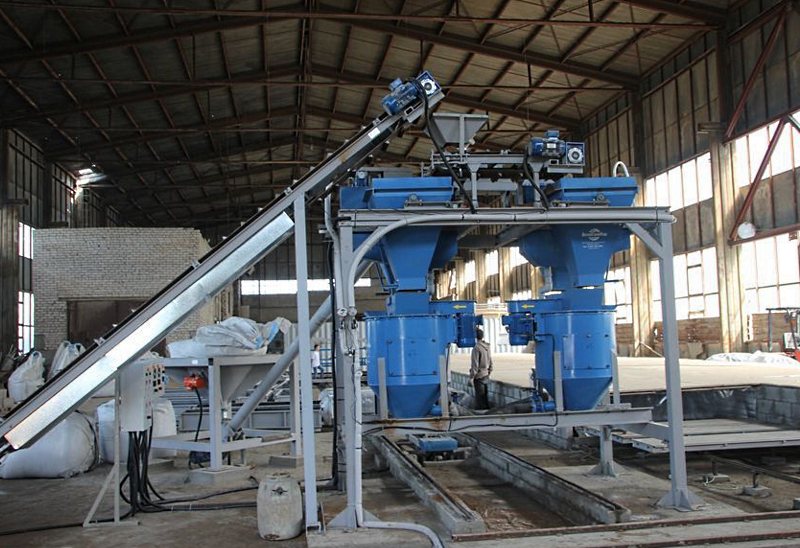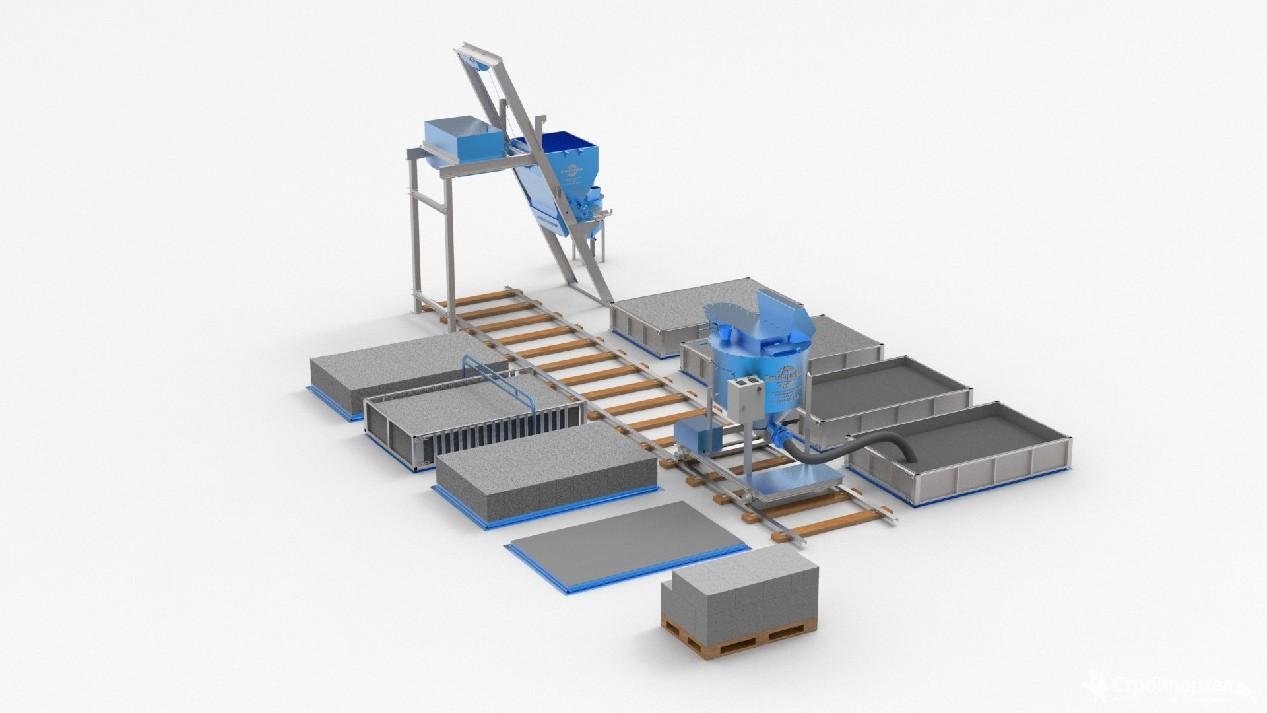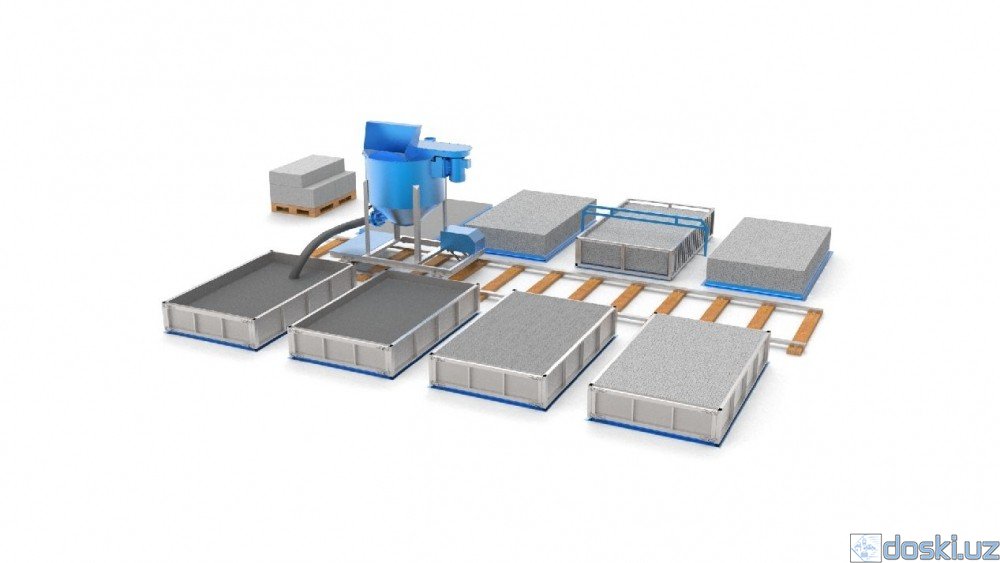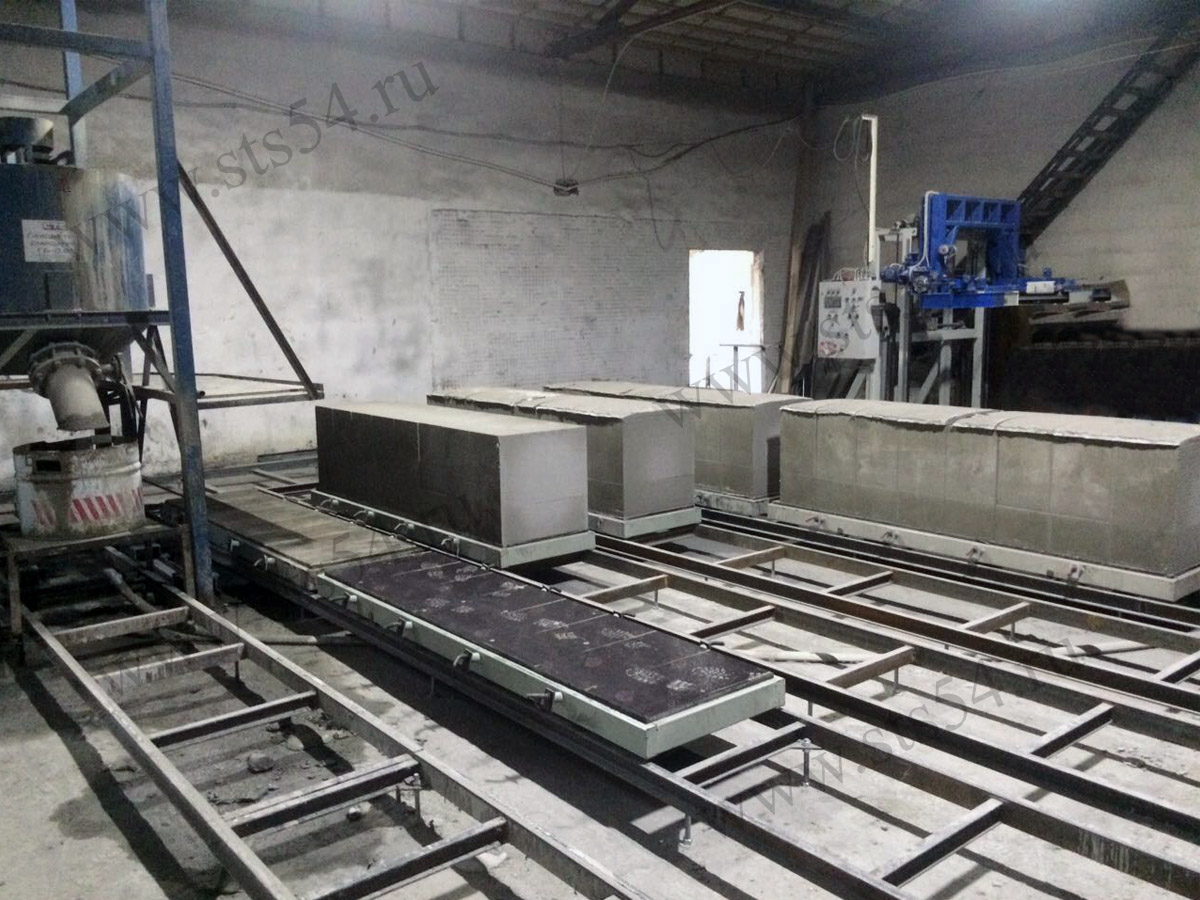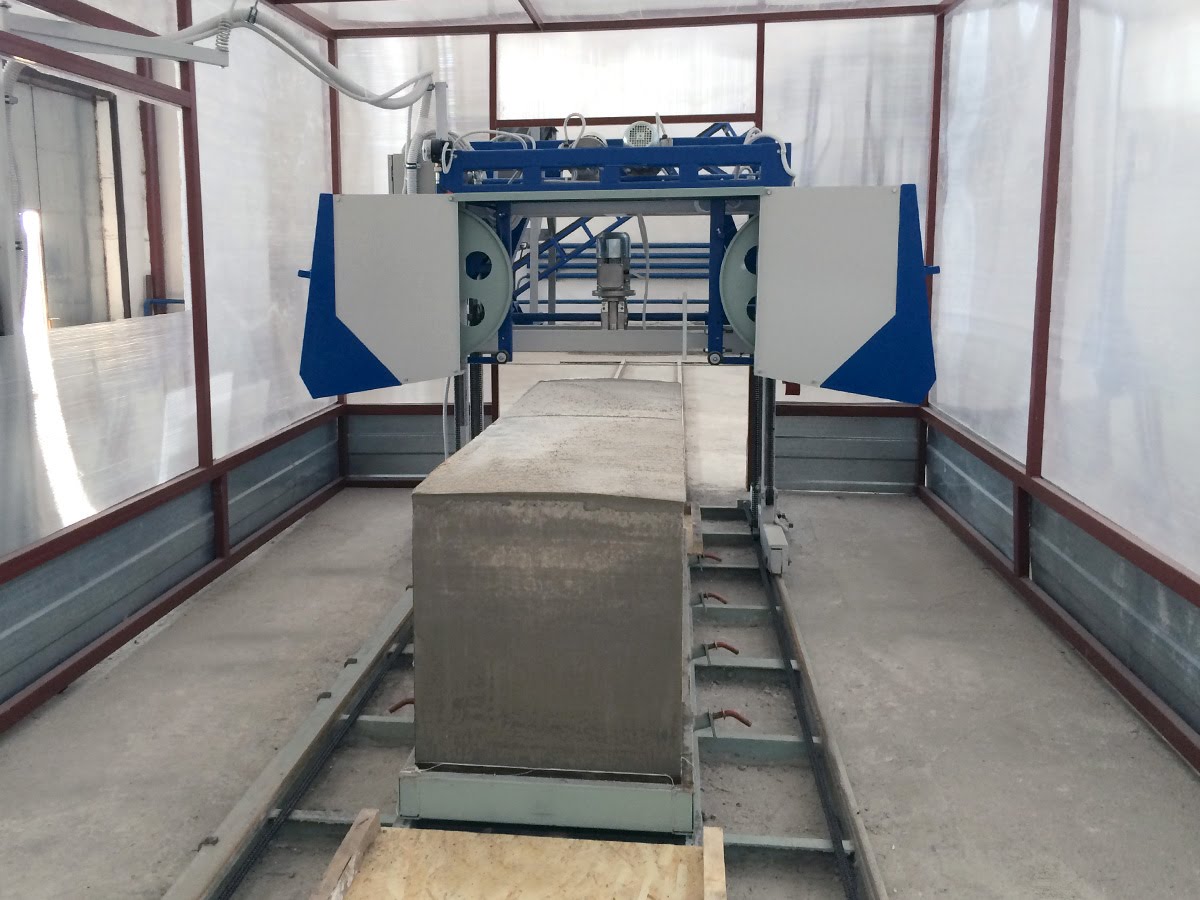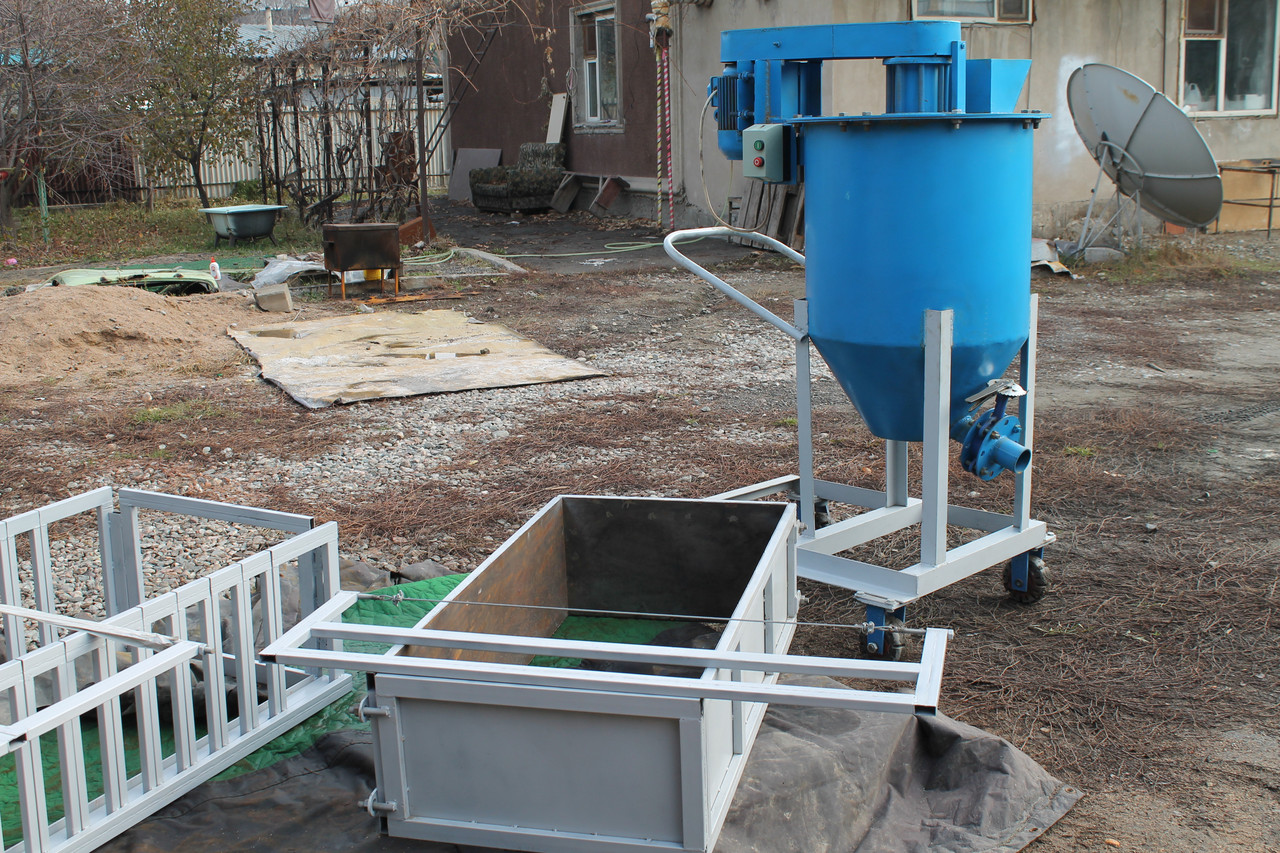Expenses and income
The production of aerated concrete is a profitable business, especially if it is possible to invest in good equipment that allows you to create high-quality blocks that meet all the established characteristics.
The main stages of business organization:
Preparation of documents - within 14 days or more, with the choice of the form of ownership, the possible involvement of a lawyer.
Searching for premises for rent or purchase - premises are needed to organize production, warehouse, office (optional)
Attention is paid to the location of the object and the price per 1 m2, looking for a balance between the convenience of transport interchanges and costs.
Purchase of equipment - as well as adjustment, training of employees. It is advisable to give preference to recognized manufacturers, look at the warranty period, service, etc.

- Purchase of raw materials - it is advisable to immediately look for partners with the conclusion of contracts, discussion of volumes, discounts, etc. It is impossible to save on raw materials in terms of quality.
- Hiring employees - at least for production (an accountant can be outsourced, while the work of sales specialists is to be done independently).
- Launching production - starting the line, checking all processes, analyzing, finding effective solutions.
- Marketing and advertising - any methods can be used here that really pay and recoup.
- Sale of products and delivery - paperwork, purchase of vehicles, invoicing for services.

Expenses and incomes from the aerated concrete business (based on 2500 m3 per month):
- Full set of equipment - 7,000,000
- Raw materials for the production of 2500 m3 block - 4220000
- Salary, deductions (per month) - 280,000
- Utility bills - 1,650,000
- Sale of 2500 m3 blocks - 8,750,000
- Advertising costs - 480,000
- Premises for rent - 420,000
- Income (net) - 1,700,000
The payback period is about 4-5 months.
If you plan to open production with your own hands, then the numbers will be different. The most budgetary equipment will cost 40,000 or less (if there is no equipment at all, but a concrete mixer or a bucket with a mixer is used), the production cost is 2,000. When making an 85 m3 block, the cost of aerated concrete is 170,000, plus the price of equipment 40,000, it turns out 210,000.
The finished product in the store costs 3,500 rubles per cubic meter, 85 cubes will cost 297,500 rubles. That is, even with a one-time use of the equipment, the savings will amount to 87,500 rubles. On the other hand, the quality of the blocks will be completely different from that of aerated concrete produced in an autoclave plant.
Calculation of the pile foundation
Select the type of grillage:
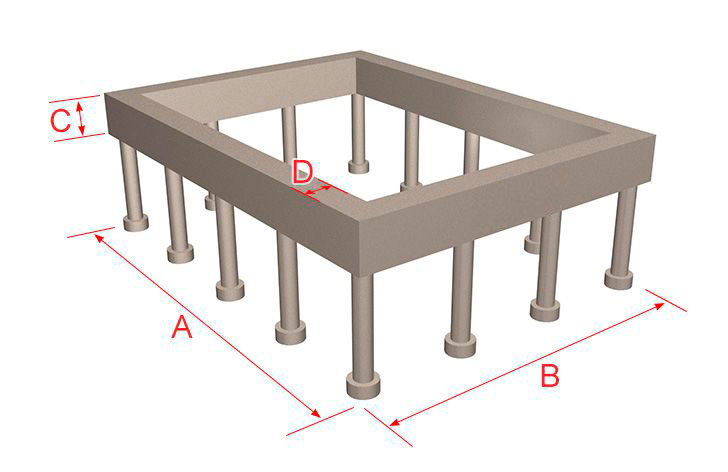
Grillage parameters:
Grillage width A (mm)
Grillage length B (mm)
Grillage height C (mm)
Grillage thickness D (mm)
Concrete grade
M100 (B7.5) M150 (B10) M200 (B15) M250 (B20) M300 (B22.5) M350 (B25) M400 (B30) M450 (B35) M500 (B40) M550 (B45) M600 (B50) M700 ( B55) M800 (B60)
Poles and piles parameters:
Number of poles and piles (pcs)
Column diameter D1 (mm)
Post height H1 (mm)
Post base diameter D2 (mm)
Post base height H2 (mm)
Reinforcement calculation:
Rebar length (m)
Calculation of the grillage formwork:
Board width (mm)
Board length (mm)
Board thickness (mm)
Calculate
# 1. Aerated concrete by type of production
For the production of gas blocks, cement, sand and special gas generators (usually aluminum dust) are used, sometimes lime, gypsum, as well as industrial waste, including metallurgical slag and ash, are added. The mixture is diluted with water, poured into a pre-prepared mold, where the reaction of aluminum interacts with cement or lime mortar. The resulting hydrogen foams the cement slurry, resulting in the appearance of spherical pores communicating with each other with a diameter of 1 to 3 mm. After setting the resulting solution, it is removed from the molds, cut into blanks and dried.

By the type of final processing, aerated concrete blocks are divided into:
- autoclave. Their hardening takes place in autoclaves under the influence of saturated steam supplied under high pressure. It is a more durable and expensive material. Such blocks are recommended to be used for the construction of load-bearing walls;
- non-autoclave. They harden in electrically heated drying chambers or in natural conditions. Their main advantage is a lower price due to a simplified production method.
What is aerated concrete, its technical characteristics

Aerated concrete is one of the varieties of aerated concrete. The building material is an artificial stone with a porous structure. The pores are evenly distributed throughout the volume and have a rounded or oval shape. Their diameter does not exceed 3 mm.
According to the manufacturing technology, aerated concrete is classified into 2 types:
- autoclave;
- non-autoclave.
The material is used in the construction of residential and non-residential buildings. Most often, walls and partitions are built from it. Reinforced aerated concrete is used for the manufacture of floors.
The material includes:
- cement;
- sand;
- lime;
- gypsum;
- finely dispersed metallic aluminum;
- ash;
- slag.
Consider the technical characteristics of aerated concrete:
- The length of the products is 62.5 cm, the height is 25 cm.The width can be different - from 10 to 40 cm.
- Due to the porous structure, the material has a low weight - the mass of 1 m2 is 600-800 kg.
- The thermal conductivity of aerated concrete differs depending on the brand and ranges from 0.048 to 0.28 W.
- Shrinkage of the material - 0.5 mm / 1m.
- Frost resistance is 2 times higher than that of bricks - more than 70 cycles.
- Aerated concrete is not subject to combustion.
Advantages and disadvantages of aerated concrete blocks
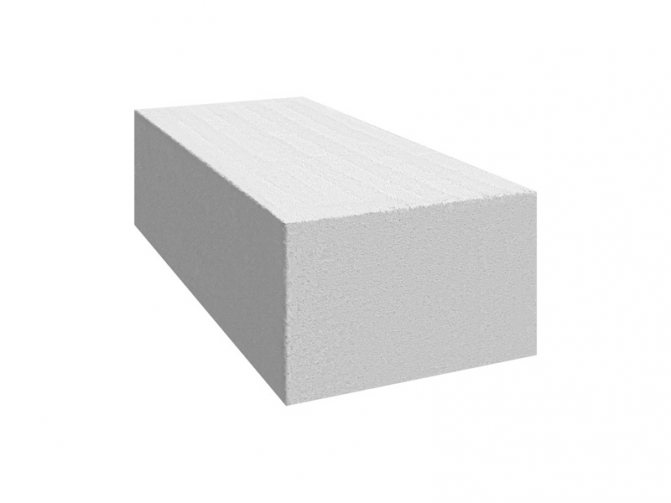
Aerated concrete is a relatively "young" material; it has been used in the construction market for about 80 years. However, he has already managed to gain popularity due to its advantages:
- high environmental friendliness;
- fire resistance;
- low density and, as a result, low weight;
- ease of processing;
- high speed of construction of structures;
- excellent thermal insulation properties;
- low cost.
Aerated concrete as a building material is not without its drawbacks. It is fragile - blocks may break during transportation or laying. Another disadvantage is high water absorption capacity. Walls built of aerated concrete will have to be protected from moisture. Structures made of this material quickly heat up and cool down. Lime, which is part of the composition, has a destructive effect on metal parts that are used in construction.
Types and technology of material production
Aerated concrete is produced in two ways - autoclave and non-autoclave. In the first case, the blocks are placed in a special oven, where they quickly solidify at a high temperature. In the second case, the products are dried naturally for several days. In terms of quality characteristics, gas blocks obtained by the non-autoclave method are inferior to products that have undergone heat treatment in an oven.
The technological process includes the following stages:
- preparation of raw materials;
- preparation of a mixture in a batching and mixing machine;
- pouring mass into molds;
- cutting blocks into products of the required size;
- autoclaving;
- packing of finished aerated concrete blocks.
First, the raw materials - Portland cement, sand sludge, lime, water and binding components are loaded into the batching and mixing section. The components are mixed in the right proportion and turn into a homogeneous mass.
Further, the mass enters the mold, where intense gas formation occurs as a result of a chemical reaction. When the process of active gas evolution stops, the molds are kept at room temperature or in a heat chamber until the raw strength reaches 0.04–0.12 MPa. Then the molded products go to the cutting complex.Here, with the help of special steel threads or strings, the plate is cut lengthwise and crosswise into products of the desired size.
After cutting, the blocks are transported on autoclave trolleys to the oven. After it is fully loaded, the products are processed at a temperature of 190 degrees and a pressure of about 12 atmospheres. A certain humidity regime is maintained inside the oven. The finished products are unloaded from the autoclave after gradual pressure reduction. Aerated concrete blocks are delivered to the packing department and sent to the finished product warehouse.
In the production of aerated concrete by the non-autoclave method, the mixture in the molds hardens naturally, without the use of ovens. To improve the properties of the material obtained by this method, modifying additives must be included in the mixture.
More about autoclaving
Now let's talk in more detail about the autoclaving of a gas block and see what the main differences are between self-produced products and material produced in a factory.
What is autoclaving?
With the help of autoclaving, it is possible to improve the quality of finished products.
- The blocks, cut into standard sizes, are placed in an autoclave and processed under the influence of pressure above atmospheric with water vapor, with a high temperature prevailing.
- Processing lasts for 12 hours.
- Upon completion of processing, the blocks can be used in construction almost immediately, because they have already reached the brand strength.
- Non-autoclave gains strength within 4 weeks.
- Autoclave treatment improves such qualities as: strength, density, durability. Products become less fragile
It should be noted that the manufacture of autoclave hardening blocks is possible only in the factory.
 Autoclaving process
Autoclaving process
Comparison of autoclave and non-autoclave gas block
And now let's compare the properties of autoclaved aerated concrete and products that achieve strength in a natural way.
| Characteristic | Comparative analysis |
|
|
Due to specialized processing in an autoclave, synthetic hardened products are distinguished by the best combination of density and thermal conductivity. |
|
|
In accordance with GOST, the frost resistance requirements for the non-autoclave block are somewhat lower.
The exact terms of the durability of both products have not been established empirically, due to the insufficient time of existence of the material on the building materials market. |
|
|
The autoclave has almost perfect geometry. A home-made non-autoclave block is seriously inferior to it in this respect. |
|
|
Equipment for autoclaved aerated concrete, in general, differs only in the presence of autoclaves. The production technology is the same, the order is the same. |
|
|
Non-autoclave blocks are more vulnerable to mechanical stress, they are more fragile. |
|
|
Autoclave products are about 10% more expensive. |
|
|
Non-autoclave blocks are more prone to shrinkage. The indicator is up to 1 mm / m2. |
Plant and line types
Now let's go directly to the overview of the types of equipment.
Conveyor type
Equipment for conveyor-type aerated concrete is different:
- Maximum automation of production;
- Minimum employee participation;
- High cost;
- Large production volumes;
- Complete set;
- And usually the most profitable.
 Large conveyor line
Large conveyor line
Let us consider in more detail the configuration and capabilities of such aerated concrete equipment using the example of the line of a popular Chinese manufacturer, which is a dealer of Premium Brick Plus.
The standard kit includes:
Containers and bunkers for raw materials;
 Raw material hopper
Raw material hopper
Belt conveyors for transporting components;
 Belt conveyor
Belt conveyor
Mortar mixing unit;
 Concrete-mortar unit
Concrete-mortar unit
Autoclaves;
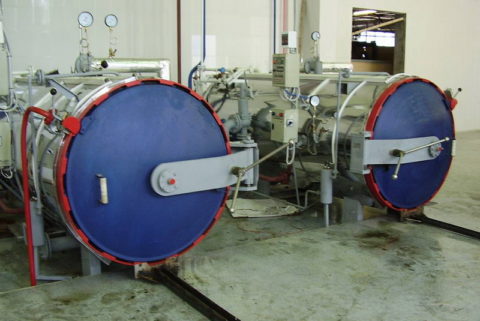 Autoclaves
Autoclaves
Forms;
 Precast block mold
Precast block mold
- Cutting complex;
- Mixing conveyor;
- Crushers;
- Carts;
- Node for automatic line control;
- Fork loader.
Such equipment for production costs about 55 million. Agree, the amount is not small. However, at the same time, the productivity is about 300 thousand cubic meters per year. The area required to accommodate such a line should be about 4000 m2.
Alternatively, consider purchasing a used conveyor line. This is a kind of risk, but its cost is much lower.
It is also worth paying attention to the mini-line of the conveyor type "Inntech-100". Its productivity is much lower and amounts to 100 m3 per day.
Its price is about 3,000,000.
 Mini conveyor line
Mini conveyor line
This line is characterized by a fixed mixer. The molds move along the rail conveyor like a trolley. Components are fed and dosed in automatic mode. The cutting complex is mechanical.
Lines of renowned German equipment manufacturers are most valued among manufacturers. They are distinguished by high productivity, durability in use. With their help, you can make blocks of the highest quality.
 German equipment for the manufacture of aerated concrete
German equipment for the manufacture of aerated concrete
The video in this article will demonstrate the principle of operation of equipment for the production of aerated concrete.
 Aerated concrete production Porevit
Aerated concrete production Porevit
Stationary type
- This type of equipment is much less expensive. However, its productivity is much lower and amounts to about 50 m3 per day.
- As a rule, a set of such lines includes component dispensers and a belt conveyor, which feeds the ingredients into the mixer.
- However, such a kit can no longer be called fully automated. For a full-fledged work, at least several people are required.
- The required area for the production and warehouse location is about 500 m2.
 Stationary line for the production of aerated concrete block
Stationary line for the production of aerated concrete block
As an example, let's briefly consider the configuration and capabilities of the ACM-1MS line.
- The capacity is about 60 m3;
- The work will require the involvement of 3-4 people;
- Sand and cement are fed automatically.
Equipment:
- Mixer for binder and other components;
- Construction for cutting block mass with saws;
- Forms and pallets;
- Conveyor.
Mobile plants and mini-lines
Such equipment for the production of aerated concrete blocks is ideal for novice entrepreneurs or developers who want to make products for their own needs.
With the help of a mobile installation, only non-autoclave curing aerated gas blocks can be produced. Below we will look at its main differences from its main competitor.
Such equipment requires a 220 W network, while other types of machines require a 360 W connection. The production volume is about 2-10 m3 per day.
 Mobile plant for the production of aerated concrete
Mobile plant for the production of aerated concrete
Let us consider the characteristics of the installation using the example of the Aerated Concrete 500B set.
 Installation of aerated concrete 500 B
Installation of aerated concrete 500 B
- The set includes: mixer, connecting hoses and compressor. The production requires the participation of several people.
- Almost the entire process of work takes place with the participation of a person. In automatic mode, only mixing is performed.
- Dosing will also have to be done on your own.
- The volume of release is 3 m3 of porous mixture.
- Mixing capacity - 500 liters.
Mini-lines are more productive. With their help, it is possible to manufacture up to 25 m3 per day. For small entrepreneurs, it is a great option to start a business.
The principle of their design is similar to that of a mobile installation, more power and volume of the mixer.
Instruction for the manufacture of block material
When planning to produce block aerated concrete at home, it is advisable to study all the nuances and features in advance, prepare the necessary materials and tools.
Aerated concrete production at home:
- Creation of a pencil case from wooden boards, installation of jumpers along the entire length (so that the overall frame is divided into cells according to the size of future blocks). Use waterproof plywood, fix it as firmly as possible. It is advisable to make several shapes of different sizes.
- Boards are treated with machine oil diluted in water or with special compounds to eliminate the likelihood of concrete sticking to the surface.
- For mixing concrete you will need a compressor, mixer, sleeves. The installation is suitable for both a one-off production and a mini-line. You also need to prepare a metal wire in advance, which is used to remove excess solution.

In the absence of a dispenser, the finished raw materials are weighed independently, accurately observing the proportions in order to achieve the best quality of the material.
All components are loaded into the mixer, thoroughly mixed until a homogeneous foamed mass is obtained.
The mass is poured into molds up to half the volume, so that the mixture has a place to rise.
Wait for foaming, then remove the excess mixture (5-6 hours after pouring).
After 14 hours, the formwork can be dismantled by gently knocking on the walls of the mold.
The material is left indoors or outdoors for 28 days, allowing it to dry.
Equipment for aerated concrete is presented on the market in a wide variety, therefore, first of all, before choosing and buying it, you need to decide on the budget, premises, requirements (average line productivity, number of employees). Installations can be purchased from both domestic and foreign manufacturers. German is considered one of the best.
For mobile mini-lines, everything you need can be purchased separately for a moderate amount and assembled yourself. The most expensive installations are conveyor lines, the cost of which is estimated in millions of rubles, but the performance is appropriate.
Material and product specifications
Aerated concrete blocks have a number of different characteristics that represent the structure of properties and qualities. Let's consider the main ones taking into account the existing GOST requirements.
Accuracy categories, standard sizes
There are 3 main categories of accuracy, the main difference being geometric deviations. Technical characteristics such as frost resistance, density, strength do not cost depending on the category.
Standard block sizes: Length 625 mm, height - 250 mm, width - 100, 150, 200, 250, 300,400 mm.
 Common sizes
Common sizes
Many manufacturers offer custom-made production of any size, but the material is quite simple to process, which practically excludes the demand for such services.
Medium density
The products have a porous structure, which ensures low weight and low density. This advantage makes the material even more popular.
 Density of products in comparison with other building materials
Density of products in comparison with other building materials
Thermal conductivity
To determine the thickness of the wall of the future building, you will definitely need the thermal conductivity coefficient. It ranges from 0.048 to 0.28 W. Read more about the thermal conductivity of aerated concrete.
Thermal conductivity of the gas block in comparison with other wall materials
Vapor permeability
The ability of the material to accumulate moisture and give off equally both inside and outside the building, forcing the owners of buildings made of this material to protect the walls.
Compressive strength
An indicator that indicates the maximum permissible load. Varies from B2.6 to 4. As a rule, the actual load should be less.
Fire safety. Shrinkage
The gas block is one of the safest materials; it is included in the list of non-combustible substances.Shrinkage according to GOST indicator corresponds to no more than 0.5 mm per 1 meter.
 The visual difference between two representatives of aerated concrete
The visual difference between two representatives of aerated concrete
Advantages and disadvantages of aerated concrete products
The material belongs to one of the most common materials used in the manufacture of products for construction. There are more and more people who want to run a business for the production of such blocks. But, like any material, aerated concrete has its pros and cons.
Let's take a closer look at all the advantages and disadvantages:
| pros | Minuses |
| High environmental friendliness of the material; fire resistance | Fragility of blocks. This often manifests itself during masonry work and transportation. |
| Low density and, as a result, low load | Increased water absorption capacity |
| High construction speed in comparison, for example, with bricks. | Difficulty in attaching heavy objects to the wall. |
| Ease of processing, the block can be given any desired shape. | The presence of lime in the gas block is also a lack of material. Over time, the metal components used for masonry deteriorate. |
| Relatively low cost | Low building inertia. Any constructed structure heats up quickly and cools down just as rapidly. |
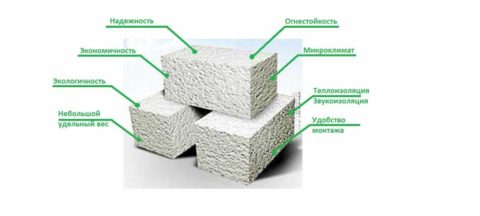 Product advantages
Product advantages
Aerated concrete production technology
Aerated concrete can be autoclaved and non-autoclaved. Non-autoclave building material is cheaper, because it is characterized by fragility, and less money is spent to ensure the production of the material, since you do not need to purchase expensive equipment - an autoclave, pay for electricity for its operation, and also invest in its maintenance. Non-autoclave production technology is carried out in accordance with a specific algorithm:
- Weighing the components of the mixture in accordance with the recipe.
- Mixing by hand or using special equipment.
- Unloading to forms.
- Exposure of the product.
- Removing finished products from the mold.
Due to the fact that gas formation will occur as a result of chemical reactions occurring in the mixture, the forms are only half filled. Waiting for the completion of the reaction takes up to four hours, during which the components completely occupy the volume of the form. After the surplus composition is taken from the molds, it is left for aging, which will last up to 16 hours, after which the formwork is stripped and reloaded onto pallets to gain tempering strength, which lasts three days. After the completion of all operations, the product is sent to the warehouse, however, it can be sold only after a month, when it gains brand strength.
The production technology at the first stages of work practically does not differ from the autoclave-free method. The required amount of all components is collected using dispensers, loaded into the mixer and mixed. To accomplish this task, the use of a concrete mixer is allowed. 15 minutes after the end of the mixing of the starting ingredients, aluminum powder is introduced, which is a blowing agent. The substance reacts with the base mix without an autoclave.
The mixture of raw materials is poured into molds and kept for 6 hours, after which the gas blocks are cut, which must subsequently gain density over 18 hours. After completing basic operations, autoclaving is performed. The formed blocks of aerated concrete are loaded into a sealed furnace chamber, in which, at a high temperature, each block is treated with water vapor under a pressure of up to 12 kg / cm2.
Non-autoclaved product is dried in natural conditions. Autoclave products do not require drying, but they still need to be cured for a month before curing.
An important stage in the production of both types of aerated concrete is the preservation of integrity during transportation to the consumer.To accomplish this task, it is necessary to pack the finished product in a shrink film and transport it on wooden pallets.
What is autoclaving of aerated concrete
If we are talking about autoclaved aerated concrete, then it necessarily goes through the autoclaving process. Autoclaves are called large containers in which a high temperature (160-180 C) and a pressure of saturated water vapor are created.

The autoclaving process lasts about 12 hours, and its task is to quickly set the strength of aerated concrete. Ordinary heavy concrete gains 70% of its brand strength in about a month, but if the temperature is increased to 180 degrees, then strength will be gained 100 times faster.
This solves several problems at once: there is no shrinkage of the blocks, it does not take time for the strength of aerated concrete. Next, aerated concrete is packed in a protective film and delivered to customers.

Fresh autoclaved aerated concrete is very humid, water in it is about 30-40%. Due to moisture, its density is significantly higher than stated. Therefore, before finishing work, the laid out aerated concrete wall must dry out for at least two seasons.
Autoclaved aerated concrete has a higher strength than non-autoclaved aerated concrete.
In scientific terminology, autoclaved aerated concrete is called tobermorite - an artificial porous stone. Since stones are minerals, they are absolutely environmentally friendly. Aerated concrete does not emit any harmful substances and is not radioactive.

General technology for the production of aerated concrete
Required raw materials
To prepare an aerated concrete mixture, you will need the following raw materials:
- Cement grade not less than M400;
- Water;
- Quicklime;
- Gypsum;
- Quartz sand;
- Aluminum powder.
 Aluminum powder
Aluminum powder
It also does not hurt to add a plasticizer to the solution. Its main purpose is to increase the plasticity of the solution, which prevents cracking of products at the stage of drying and hardening.
 Plasticizer
Plasticizer
Other chemical additives are also used. As a rule, they are added in order to improve the quality of the finished product.
Proportions of raw materials with additives
- The silica component can be presented in the form of: sand, ash and other by-products of the industry;
- The type of binder can also be different: cement, slag, lime, mixed, ash.
The approximate content of the proportions is as follows:
- 50-60% - cement;
- 20-40% - sand;
- 1-10% lime;
- Up to 1% - water.
 Proportions depending on the desired density
Proportions depending on the desired density
Main steps
A quick guide looks like this:
- First of all, the components are weighed and mixed in the required proportions. When making with your own hands, this is done manually, at the factory, as a rule, in automatic mode.
- All ingredients go to the mixer where they are mixed.
- The next step will be molding. The molds are filled by about 1/3, since during pore formation the mixture can simply flow out.
- Then, after the completion of the swelling process, some time is waited until partial solidification.
- Next, a single layer is cut or simply stripped, if the forms are used of ready-made standard sizes.
- The last step will be autoclaving or sending the blocks for drying using a non-autoclave production method.
Potential risks
Opening a workshop for the production of a gas block is a business that is associated with some risks, which, however, will not be so great if you initially think over the development strategy to the smallest detail. The most likely risk factors include the following:
- Increase in prices for utilities and, as a result, an increase in the cost of production.
- A drop in sales due to a decrease in demand for aerated concrete blocks due to the unstable economic situation in the construction sector of the region.
- The emergence of new building materials on the market, which, in terms of their properties and prices, surpass the "classic" aerated concrete blocks.
- An increase in the level of competition in the construction sector of the region, which may lead to a forced dumping of prices for the products of the aerated concrete block production plant.
Finally, I would like to note that in the presence of stable sales and supply channels for raw materials, the threats of any of the above "emergency" situations can be leveled without serious negative consequences for business development.
Components for making a mixture
To make aerated concrete blocks with your own hands, you need to prepare the following ingredients:
Aerated concrete block size table.
- For each cubic meter of finished aerated concrete (at the exit), approximately 250-300 liters of water are required. This should be clean drinking water. It is best to take it from the surface layers of any clean source.
- Approximately 260-320 kg of cement is required per cubic meter of finished aerated concrete. For self-production, grades M500D0, M400D0 are used.
- Quarry sand, river, cleaned. Its quantity per cubic meter of finished mixture is 250-350 kg. It is best to take a small one, the particle size of which is up to 2 mm. In no case is the content of branches, debris, clay allowed.
- Special additives for aerated concrete. The amount is 1-3 kg for each cubic meter of the finished mixture.
- A blowing agent, i.e. aluminum powder. Enough 0.5-0.7 kg for each finished cubic meter of concrete. Powder is needed in order for the reaction to start in the mixture, which is necessary for gas formation. During mixing, gas begins to evolve, bubbles and cells form inside the concrete, which give the composition the qualities it needs.
- Lubricant for containers in the amount of 0.3-0.5 kg per cubic meter Before starting filling with emulsions, the molds are thoroughly lubricated. Waste oils must not be used as they contain a large amount of soot.
Making aerated concrete with your own hands is not so difficult, but it is important to follow all stages of production exactly, to select the ingredients for the future mixture in the correct proportion. Equipment list:
Equipment list:
- Forms for pouring future aerated concrete blocks, which may have different sizes. It is best to purchase ready-made containers.
- Strings, which are necessary to remove excess mixture from the surface of the forms.
- A concrete mixer that will be used to mix the mixture.
Ingredient requirements
Comparison table of the characteristics of aerated concrete and foam concrete.
It will not work to make a large amount of building material on your own, but they will be enough for the construction of a small house. The weight of one standard size block can be approximately 650 kg. Therefore, the presence of several people is necessary, not only for laying the walls, but also for filling forms, pulling out aerated concrete blocks from containers. When all the conditions are met, aerated concrete blocks will turn out to be durable and of high quality, their cost will be less than when buying ready-made material.
You can use special installations that mix aerated concrete in automatic mode. They can be rented, but on the other hand, the equipment doesses the ingredients on its own, mixes the concrete of exactly the quality that is needed. The rental costs will be justified.
The proportions of aerated concrete can be different, but it is best to adhere to the following formula (for D-600 aerated concrete):
- Portland cement PC500 D0 - 65%;
- refined sand - 30%;
- dolomite - 5%;
- W / T - up to 0.48.
Lime flour, i.e.
dolomite, can contain up to about 10% of aerated concrete, but it is important to determine what color of blocks is needed. With a larger amount of lime, the color of aerated concrete blocks will be lighter
A large amount of powder is also not required, it acts as a catalyst for the gassing reaction.
Features of aerated concrete production technology
The manufacturing process prior to autoclaving consists of the following steps:
- Preparation and dosing of all components, except for the gas generator, and their thorough mixing in mixers for 5 minutes.
- Injection of aluminum powder and final mixing - 1 min.
- Pouring the resulting liquid mixture into pre-prepared forms: from 1/3 to 2/3 of their volume. No more than 20 minutes are allocated for this stage.
- Exposure in molds: from 2 to 4 hours before the end of the gassing process.
- Removing forms, trimming surplus with string cutting tools, if the appropriate equipment is available - making groove holes.

Further steps depend on the possibility of autoclaving. When produced at home (or close to them), the blocks are simply kept on pallets for at least two days at an ambient temperature of +20 ° C, then another 21-28 days at normal humidity. After a month, such products are ready for use, inferior in strength to factory ones, they are quite suitable as insulation or for filling the space between rigid frames. Their performance is directly dependent on the activity and proportion of the binder.
The main material for the manufacture of structural blocks is autoclaved aerated concrete. In this case, the cut blanks are placed in special chambers and treated with hot steam under high pressure. Approximate parameters of the environment inside the autoclave: +200 ° С, at least 10 atm, it is impossible to achieve them at home without appropriate equipment. In the process of processing, the walls of the cells are strengthened and gas formation is successfully completed, as a result, the blocks improve their insulating and strength properties. Autoclaved aerated concrete better withstands moisture loads and has a higher frost resistance.
This technology increases the cost of the units even when buying used heat treatment equipment: it is most often stationary, it needs a reliable foundation and input into the boiler production scheme to generate steam. In order to save money, many entrepreneurs first launch a line for the production of non-autoclave gas blocks, envisaging in the future the installation of an autoclave. This stage can be dispensed with when molding products intended for thermal insulation.









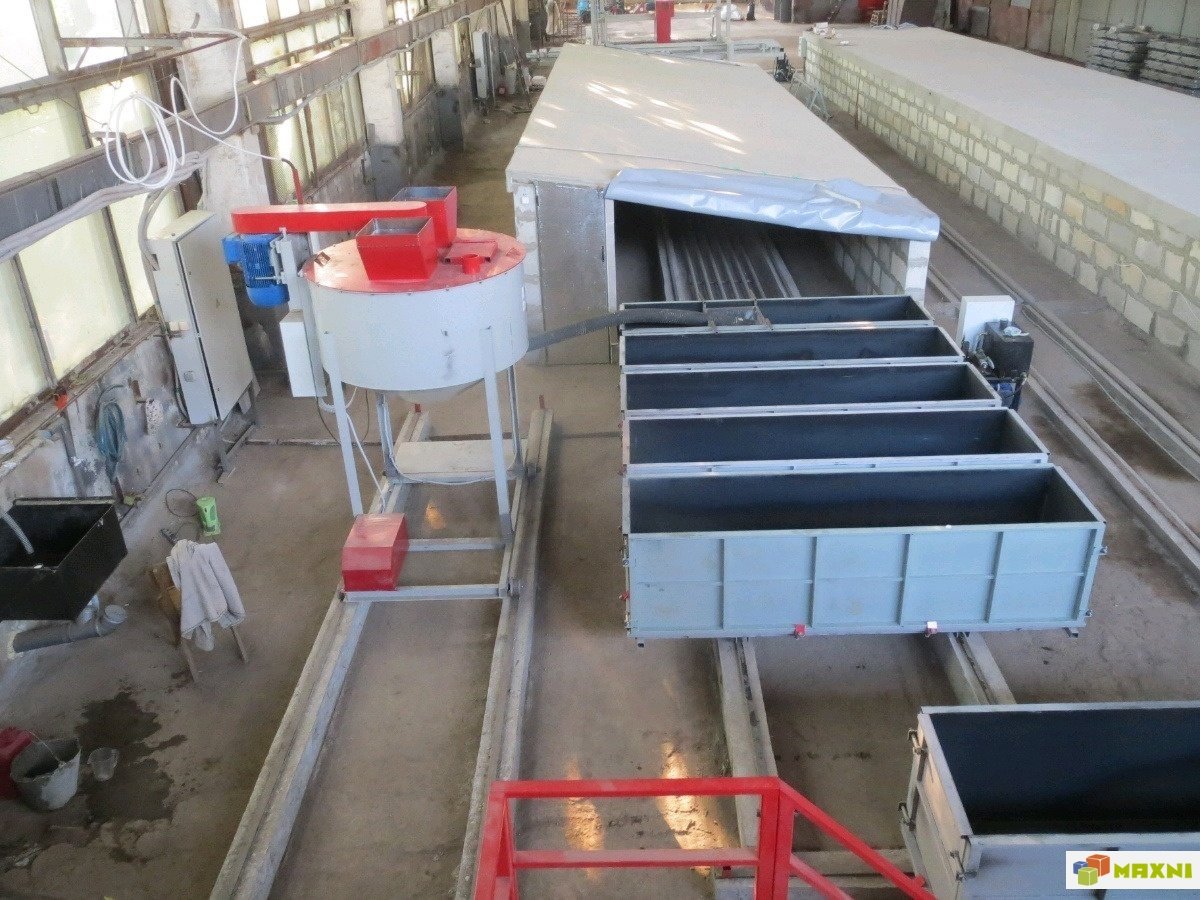

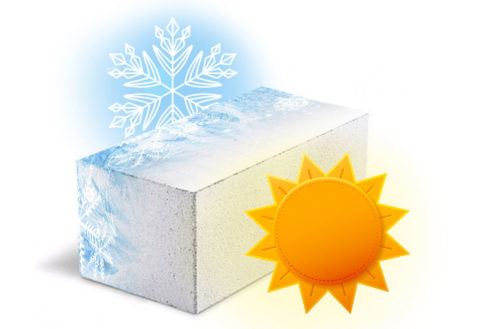 Frost resistance and durability
Frost resistance and durability Appearance and geometry of the product
Appearance and geometry of the product Equipment requirements and manufacturing complexity
Equipment requirements and manufacturing complexity Fragility
Fragility Price
Price Shrinkage
Shrinkage
